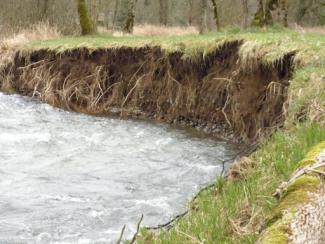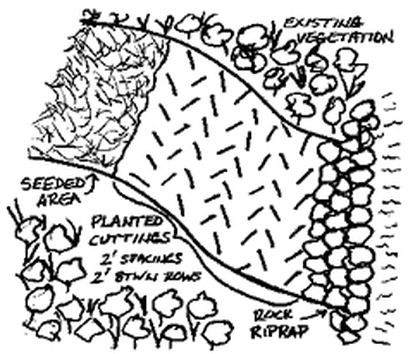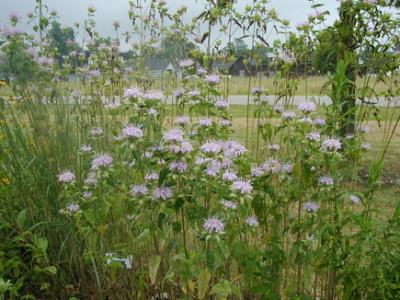
(This page has some outdated references, stay tuned.)
Stream bank erosion is common along rivers, streams and drains where banks have been eroded, sloughed or undercut. However, it is important to remember that a stream is a dynamic and constantly changing system. It is natural for a stream to want to meander, so not all eroding banks which are slowly eroding are "bad" and in need of repair.
Generally, stream bank erosion becomes a problem where development has limited the meandering nature of streams, where streams have been channelized, or where stream bank structures (like bridges, culverts, etc.) are located in places where they can actually cause damage to downstream areas. Stabilizing these areas can help protect watercourses from continued sedimentation, damage to adjacent land uses, control unwanted meander, and improvement of habitat for fish and wildlife.
Determine the Severity of the Problem
Some stream bank erosion is natural. But bare, vertical banks, undercut banks, or areas of sloughing banks are indicators of serious erosion problems.
In general, severe bank erosion will require more intensive stabilization measures which require engineering design and equipment not readily available to the riparian landowner or stream adopter. In addition, all measures needed must be approved by and any required permits secured from the Michigan Department of Environmental Quality (MDEQ), before any work is done.
Stabilization and Protection Measures
There are a variety of stream bank stabilization and protection measures that can be used. One or a combination of these measures may be needed, depending on the particular site and erosion situation. The proper design and installation of stream bank erosion control measures is dependent upon the flow characteristics (i.e. velocity, discharge, etc.) of the stream, the soils, the slope and the current land use. Some stream bank stabilization measures include:
Obstruction Removal
Removal of fallen trees, stumps, debris, sand and gravel bars that may cause local current turbulence and deflection.
Bank Sloping
Grading of banks to a stable slope, so structural or vegetative measures can be effectively installed.
Riprap
Placed or dumped heavy stone, properly underlaid with a filter fabric, to provide armor protection for stream banks.
Jetties
In-stream deflectors commonly constructed of posts, logs or rocks, which project into the stream to protect banks at curves and areas subjected to high velocity currents.
Revetments
Pervious or impervious structures built on or parallel to the stream to prevent scouring streamflow velocities adjacent to the stream bank.
Vegetative Controls
This can range from complicated methods to simplified methods. A complicated method would be the "Palmiter Method" which uses felled or fallen trees placed on eroding banks and secured with cables sunk into the bank or on the top of bank slopes. A simplified method is using existing native plant materials or grass seedings to cover and stabilize exposed soil. (See under "Riparian Landowner Action" below.)
Contact Officials
- Contact the Washtenaw County Water Resources Commissioner's Office (734-222-6860) to determine if your stream is a designated county drain and what is needed to stabilize the problem.
- If your stream is not a designated county drain, contact the Michigan Department of Environmental Quality, Jackson District Office (517-780-7690) to report the problem, request assistance in determining what is needed to stabilize the problem, and to obtain any needed permits, if you will do the work.

Riparian Landowner Action
If the eroded bank areas are on your property, if they are small and the bank slopes are not very steep, you may be able to try some "do it yourself" rip-rap or vegetative measures, using existing native plants and/or grass seed.
Contact the Drain Commissioner's Office or MDEQ for approval.
Please note that removing sediment bars, stumps, fallen trees or similar material should not be done without approval by the MDEQ Land and Water Management Division.
Field stone or broken concrete riprap, placed at the "toe" of the bank (where bank meets the waterline) can reduce undercutting and provide protection for plantings done above the normal waterline.
Plantings of existing vegetation found along the stream bank can be made above the water-line and up the bank. Such plantings should be made in early spring, or fall.
Low growing woody plants with resilient stems and deep root systems are best, like willows and dogwoods. Locate nearby, healthy looking shrubs and take cuttings from wood of the previous year's growth, 1/4 to 1/2 inch thick and 12-18 inches long.
Insert about 1/2 of each cutting into the bank, spaced 2 feet between cuttings. Stagger successive rows and space them 2 feet from each preceding row, making as many rows as needed to cover the bank from the waterline to the top of the bank. Try not to dig holes to place the cuttings. Use a short piece of small diameter pipe to make starter holes, or use a wooden mallet or piece of 2 X 4 for a hammer to drive the cuttings into the bank.
All cuttings may not take, so you will need to check your plantings and replace dead cuttings each year. Future cuttings can be taken from well established previous cuttings.
If the top of the banks are not too steep and you prefer grass near the top of the banks instead of shrubs, a grass seed mixture can be used to provide stabilization on the higher, dryer bank areas. Seeding can be done in spring or fall using one of the following recommended mixtures:
- 1 lb. Creeping Red Fescue
- 1 lb. Tall Fescue
- ¼ lb. Perennial Ryegrass
- 1 ¼ lbs. per 1,000 square feet
OR Commercially lawn grass seed mixture available at your local hardware store or garden center. Seed per package rates.
The surface of the area to be seeded should be worked up with a stiff rake to prepare a seed bed. Broadcast seed over area to be seeded and lightly rake into soil. Mulch with straw. Spot seeding may be needed for several years following the initial seeding on areas where the grass seed does not take. These "do it yourself" measures are not guaranteed to work, so if they do not stabilize the erosion problem, then other measures may be required.
Professional Action
More extensive stream bank stabilization measures should be selected and installed by professionals. If you have an interest, offer to help with installation. This may or may not be feasible, depending upon liability and safety factors. Offering to apply grass seed and mulch, or help in preparing plant materials for intensive vegetative control measures will provide you the opportunity to participate in the stabilization project and gain experience in how this type of work is done.

